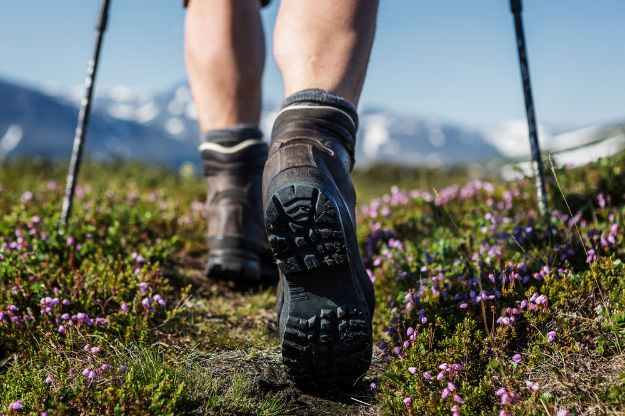HIking & Climbing
Guidelines To Extreme Hiking: A Must-Read For All Hikers
Extreme hiking is something every hiker does at least once in his or her lifetime. But when safety is ignored, extreme hiking puts the hiker in EXTREME danger. From rough terrain to unpredictable weather, safety should be your utmost concern. Remember that guy from 127 Hours?
Published
4 years agoon
By
Jeffrey Buck
Extreme hiking has always had its dangers. It wouldn’t be extreme, otherwise. I’ve gone to a number of treks and there are many things I’ve learned on trails and mountains. Though the best way to learn is always in the wild itself, I’ve written some pointers that’d help any hiker, new or old. To help you keep safe on these kinds of treks, I’ve listed down here some critical things you really need to know when you plan on going that difficult hike.
Guidelines To Extreme Hiking: A Must-Read For All Hikers
Let me tell you now, extreme hiking is really fun. But it can also be very dangerous. Even on well-established trails, extreme hiking is recreation that builds around the feelings of momentum, exploration, and adrenaline. Hikers who are unprepared or inexperienced may lose on time running around in circles, get injured, or even in some occasions, lose their lives, making fatal yet avoidable mistakes. Hiking is highly desirous as a pastime, but those strapping on their boots should remember that there is a danger to trekking, whether you do so in great heights or in faraway places. With that, here are a number of things you should watch out for when you move into the sport of hiking.
1. Extreme Hiking is NOT a Disappearing Act
A fairly common mistake among hikers, even the experienced ones, is what I like to call the disappearing act. When they go out for a solitary trek to the range or to the mountains, they would disappear, not telling anyone where they would be prior to the hike. If you’re familiar with the movie 127 Hours, you might remember Aron Ralston, who got trapped for 127 hours in one of his hikes, losing his forearm in the duration of the time. Don’t be Houdini and remember to tell your friends and family where you’d be when you go hiking.
2. Mention to Someone When You’ll Be Back
While you’re at it, tell your friends or family as well the time you expect to be back from your trip. As inhibited and not spontaneous as that sounds, if worse comes to worst, you might just be thankful to know someone will start to worry and look for you once this particular time you’ve set has passed.
3. Postpone When Necessary
Do you watch the local weather forecast before your hikes? If a storm is brewing, or the weather conditions simply would not be agreeable to your trip, postpone your hike. Many hikers have gotten hurt or have lost their lives simply because they arrogantly went on with their hiking, even with the bad weather conditions.
4. Bring the Essentials
Notwithstanding food and water, as a rule, I bring with me four essential things whenever I go extreme hiking: a lighter, a map, a compass, and a pocket knife. These four things might seem like things common-sensical to bring in your hikes but some hikers have already gotten lost simply because they didn’t know where they had been going anymore.
5. Know How To Use What You’ve Brought
Of course, if you’re bringing the essential things I just mentioned, you should also know how to use them. The map, most especially. What is a map to a hiker who does not know how to track his progress with it? Learn how to use maps and make sure you’re not walking around with things you don’t know how to use.
6. Pack Light
Packing light will save you from the hassle of carrying too much load, obviously, but it would also allow you travel with over-encumbering yourself. This is especially important in extreme hiking, since hikers who are slow to move and ultimately reach the night increase the danger of the sport.
7. Start Early, Like Really Early
Like around 4AM early. Yes, hiking is meant to be a day time activity, but we want to get to the summit by around before lunchtime. Starting your hike early means that you have ample time to climb up and descend down the range, before the sun dips down again and you have to trek with a cold and dark night.
8. Get Familiar With Where You’re Hiking
Professional hikers may seem very spontaneous when they’re out in the wilds, but that is because they’ve done their research beforehand. Get familiar with where you’re hiking by asking the locals for things to avoid or researching even the internet or library for the location’s geography. Those who prepare are more likely to have a smooth extreme hiking experience than those who decide to just wing it.
9. Learn How to Read Trail Signs
Normally there’d be trail signs on well-established hiking locations. If you see ones on the road you’re hiking, learn how to read them. Hiking routes you’re probably taking, even as an extreme hiker, will probably be full of places you need to be warned about. Hikers who don’t keep a look out for trail signs may trespass on private property or even fall in hidden ditches.
10. Be Familiar With The Predators
We’re talking about the Wilds here so you may encounter some predators along the way. Before your trip, be familiar with the predators you might be seeing along the road and bring what can be used to deter them from harming you. Bears, for example, may be genial at first, but sometimes they might see you as food. In that case bring a bear repellent spray to prevent yourself from becoming his day’s lunch.
11. Bring Copious Amounts of Water
This is very critical. Water is important for us humans. Not only in the wilds but in every day life. Dehydration is something you don’t want to occur to you, especially when you’re extreme hiking. To that end, bring copious amounts of water to keep yourself hydrated and always ready to go.
12. Sanitize Water From the Wilds
TIME SENSITIVE INFORMATION: EX-CIA Agent Takes You Through The Intensive Sharp Shooter Training He Learned In The CIA Academy. In Just 30 Days Learn To Be A Sharp Shooter Like Every Agent Leaving The Academy.
In the event that you run out of water, purify or sanitize water coming from any source in the wilds. You will need to make a heat source to boil water to remove any possible pathogens that could be lurking in the water or you could bring beforehand water purification tablets (WPT) that can easily purify the water for you.
13. Know the Different Types of Edible Plants
If you’re planning on partaking of any plants that are possibly edible, know what they are first. Not all plants are edible in the sense that they can be poisonous or detrimental to your health or the progress of your trip. Hikers have made this mistake time and again, for example with hikers who may think a particular mushroom is a Caesar’s mushroom when in fact it is the poisonous death cap.
14. Hunting Tips
Some really daring hikers may opt to find even their food source in the Wilds as well. In the event that you do decide to follow suit, don’t forget to bring a knife with a gutting hook and to cook the meat you’re partaking in well. The gut hook is for gutting animal in order for the bile not to be incorporated into the meat and also for you to be able to check the fat of the animal. If the fat is yellowish or brownish, that can only mean that the animal is cannibalistic, making its meat dangerous for you to eat. Cooking the meat well is also important because it will get rid of microbes in the meat or diseases the animal may have such as rabies.
15. Dress Appropriately
Especially when planning on embarking on trips to places that are very cold or elevated, remember beforehand to dress appropriately. With hypothermia or frostbite, any hikers can lose their limbs or their extremities. Dress with light and breathable apparel when you’re planning on hiking on sun-soaked canyons, but in cold weather places, dress in warm but not clanky clothes.
16. Consider MRE’s
Something to remember: to retain your optimal presence of mind, you will need an excess of about 2000 calories, which is the usual daily intake of a person. In this case, you may want to consider MREs or meals-ready-eat since they are easy to pack and peruse and contain a lot of calories that you may need when you are on the trip itself. Order your own MREs here.
17. Train Beforehand
Especially when you plan to hike on really precarious, expeditious locations, train right beforehand. For example, in the case of Mt. Everest, there are professionals that train people how to properly breathe when they reach a certain height where the air becomes thinner than what we as humans are accustomed to. Failure to train for cases such as Mt. Everest have proven fatal to many. It is extreme hiking after all. This article might help you.
18. Your First Aid Kit is Important
I’m sure you know this but I know personally some few hiker friends of mine who have told me stories about how they had to improvise on their first aid kit, how the things that they had in hand were not enough to cover the wounds they’ve gotten. Keep your first aid kit stocked up well and available to use always. They may save you or a friend from bleeding too much in the event an accident occurs.
19. Keep A Manageable, Consistent Pace
Rather than keeping on stopping for rest, try and develop a manageable but consistent pace when you’re hiking already. As someone who needs to keep alert of time and the trail’s extreme hiking dangers, you must always be on the go so that you’d reach your destination at the appointed time. A tip that would really be useful is to use a hiking pole as that helps by transferring some of the weight of yourself from your feet to your hands.
20. But Don’t Exhaust Yourself Too Much
You can still keep a manageable but consistent pace if you regulate your breathing and not exhaust yourself. Hikers who are exhausted or short of breath tend to lose their presence of mind, something of which you really need to have when you’re out there in the wilds, hiking, in order to navigate and get to their destination without being disoriented. So, with that said, remember to pace yourself and to take rest stops now and then.
21. Insects Can Be Dangerous As Well
Especially in places where there might be insects, don’t forget to bring insect repellents to avoid being bitten by mosquitoes who may have malaria or dengue, as well as check your hair occasionally for ticks that can transfer diseases or in worst case scenario, paralyze you.
22. Consider Bringing A Weapon
The wilds can be a dangerous place, so you may want to consider arming yourself with a weapon. Rifles would be the best because it can provide for you a means to protect yourself from a distance, although that may be too heavy for you to hike with. A pistol or a bow would suffice.
23. Protect Yourself from the Heat
Other than drinking plenty of water to avoid dehydration, consider as well wearing a light brim hat or a bandana. Although the negative effects may be not immediate, hikers who expose themselves often to too much heat may cause themselves to contract later on skin cancer. Or even just get wrinkles, which hardly looks nice on anyone.
24. Keep a Light Source Readily Available
Time passes by fast when you’re on the go, hiking. If the night reaches you and you’re still not where you need to go, you may need to produce your own light source. This will help you illuminate your way in the dark in extreme hiking and also for you to be able to see what you’re doing. Get the Hybeam Mini Pop Lamp by clicking this link.
25. In The Event You Get Lost
Don’t panic. Really. It’s easy to lose yourself once you’ve realized that you have no idea where you are. But in the event you get lost, act predictable, in the sense that you should make it easy for the rescue team to come around and fine. In the mean time, if you have one, blow a whistle at regular intervals, find shelter that isn’t obscure, and light a signal fire, so that you would be protected and yet visible enough for anyone who could help you to see.
If you’re in search of a good video regarding the dangers of hiking – or just plain going outside, then you might enjoy this documentary by NeverNotKicking!
Do you have any personal experiences with the dangers of hiking yourself? Maybe we missed something? The wilds is a dangerous place and extreme hiking is chock full of things to discover and avoid. Discuss and share it with us in the comment section below.
What do you know about camouflage? It’s more than just the outfit, and we’ll show why and how to camo, right here in this article!
Featured image via 500px.
You may like

How To Build A Debris Hut

Ironman Triathlon Podcast: What You Need To Know As An Aspiring Ironman

Awesome Family Camping Tips For Beginners

Hiking Safety Tips: What To Do When You Have Knee Pain On Trail? [PODCAST]

How To Craft Sharp Stone Tools To Survive The Great Outdoors

Mountain Bikers, Why You Don’t Want to Ride Like a Pro!

Hiking Boot Accessories
The Handgun Safety Test For Beginners
These Hunting Shotguns Are The Best Bang For Your Buck
11 Types of Guns That Will Keep You Alive On Doomsday
Best ATV Tires – The Top 6 Lightest Mud Tires
Arizona Hunting Laws and Regulations

The Top 5 Hunting Guns You’ll Ever Need For A Wilderness Walk-out

Hunting And Conservation Discussion | Call Of The Outdoors Podcast [LISTEN]
The Handgun Safety Test For Beginners
These Hunting Shotguns Are The Best Bang For Your Buck
11 Types of Guns That Will Keep You Alive On Doomsday
Best ATV Tires – The Top 6 Lightest Mud Tires
Arizona Hunting Laws and Regulations

The Top 5 Hunting Guns You’ll Ever Need For A Wilderness Walk-out































